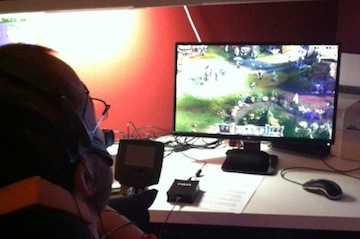Who Can Use It
Brainfingers is designed to be used by a broad
range of people with disabilities. See Testimonials
for examples of people who use Brainfingers for computer access. Even users with
minimal ability to control facial muscles can achieve Brainfinger control. The
Brainfingers Software provides methods to make use of both the ueser's brain and
user's body signals for control. See Custom
Brainfinger Editor for an example of how a user's Beta brainwave energy can
be used to create a Brainfinger switch control.
 Brainfingers provides sophisticated bio-feedback. The awareness of our brain and
body activity as reflected in our forehead signal provides a unique opportunity
for us to become aware of our brain-body connection in new ways. We can learn
to bring our brainwaves under conscious control while simultaneously retaining
an awarness of our body tension/relaxation state. See Awareness
App for an example of how we can practice this.
Brainfingers provides sophisticated bio-feedback. The awareness of our brain and
body activity as reflected in our forehead signal provides a unique opportunity
for us to become aware of our brain-body connection in new ways. We can learn
to bring our brainwaves under conscious control while simultaneously retaining
an awarness of our body tension/relaxation state. See Awareness
App for an example of how we can practice this.
People
who want to enhance their experience of video game play enjoy using Brainfingers
for control. It is possible to trigger a computer event, such as a mouse left
click or keyboard event, faster with a Brainfinger control than with your fingers.
When keyboard and mouse button control is mapped to Brainfingers while retaining
hand mouse cursor pointing the video game experience takes on a new and exciting
dimension. A video game controller called the "NIA" was created to do
this by a company called OCZ in 2008, the NIA video game play capabilities are
retained in the Brainfingers software. For those who have no other way to play
a video game, Brainfingers control is a viable option.
